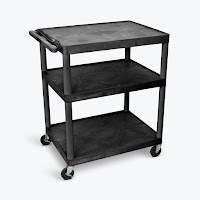Buying Guide: Light Table
Architects, engineers, drafters, graphic artists, cartographers, and even radiologists all need one thing: a light table. Light tables are exactly what they sound like—they’re tables that come with built-in lights, which illuminate their surfaces.
Light tables are often used for viewing or working on artwork, technical drawings, photographs, and x-rays. Designed like big light boxes with table legs, they allow professionals to lay sheets of paper on the tables’ work surfaces and easily display or trace them.
If you’re a professional who needs to regularly trace or closely inspect documents, you may already know that a light table is an indispensable piece of office furniture. But before you buy a light table, there are a few factors you have to consider.
Another feature you have to check is the light table’s height. Some light tables are height-adjustable, so you can raise or lower them to a comfortable working height. Most models have adjustable working surfaces, which you can tilt up to 40 degrees.
You might also want to have a light table with extra storage space. The Gagne Porta-Trace line of light tables, for instance, come with heavy-duty shelves that double as footrests.
A standard light table frame is typically made of durable materials, such as wood or stainless steel. But apart from that, the most important thing you have to check is the light table’s surface.
The surface should be sturdy enough to support your weight as you lean against the table as well as the weight of your documents and other objects. While durability is an essential feature of a light table’s surface, you shouldn’t overlook how effectively it can diffuse light. Light tables with plexiglass surfaces are shatter-resistant and offer maximum light diffusion with minimum glare. Made with ergonomics in mind, these surfaces can help reduce eye strains, so you won’t have to compromise on your eyesight as you work on your drawings all day long.
LED is known for its eco-friendly and energy-efficient properties. What’s more, LED light tables emit clean, bright lighting, making it easier to view, trace, and work on technical drawings and other documents. So when buying a light table, make sure that it uses LED as its primary light source.
Light tables are often used for viewing or working on artwork, technical drawings, photographs, and x-rays. Designed like big light boxes with table legs, they allow professionals to lay sheets of paper on the tables’ work surfaces and easily display or trace them.
If you’re a professional who needs to regularly trace or closely inspect documents, you may already know that a light table is an indispensable piece of office furniture. But before you buy a light table, there are a few factors you have to consider.
Size
When choosing a light table, the first thing you need to factor in is the amount of workspace that you need. Need to work on large sheets of drawings? You’ll probably have to get a large light table. But if you have to work on the go, you might want to consider getting a lightweight and portable light table.Another feature you have to check is the light table’s height. Some light tables are height-adjustable, so you can raise or lower them to a comfortable working height. Most models have adjustable working surfaces, which you can tilt up to 40 degrees.
You might also want to have a light table with extra storage space. The Gagne Porta-Trace line of light tables, for instance, come with heavy-duty shelves that double as footrests.
Material
Virtually no one would want to buy an easily breakable product. The same goes when selecting a light table.A standard light table frame is typically made of durable materials, such as wood or stainless steel. But apart from that, the most important thing you have to check is the light table’s surface.
The surface should be sturdy enough to support your weight as you lean against the table as well as the weight of your documents and other objects. While durability is an essential feature of a light table’s surface, you shouldn’t overlook how effectively it can diffuse light. Light tables with plexiglass surfaces are shatter-resistant and offer maximum light diffusion with minimum glare. Made with ergonomics in mind, these surfaces can help reduce eye strains, so you won’t have to compromise on your eyesight as you work on your drawings all day long.
Light Source
Old light table models were constructed with fluorescent tubes or lamps containing mercury. Because of the health and environmental hazards of mercury, most light tables today feature LED technology as their primary source of light.LED is known for its eco-friendly and energy-efficient properties. What’s more, LED light tables emit clean, bright lighting, making it easier to view, trace, and work on technical drawings and other documents. So when buying a light table, make sure that it uses LED as its primary light source.

Comments
Post a Comment